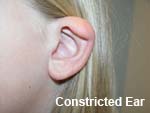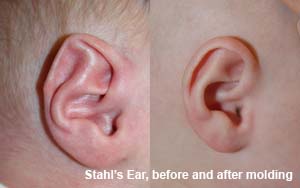Ear molding is a nonsurgical procedure that—when started soon after a baby’s birth—can correct a number of common deformities, including Stahl’s ear and cryptotia. For most cases, it eliminates the need for patients to undergo corrective plastic surgery when they are older.
 The procedure involves molding the ear using fast-drying putty such as that used by dentists, and securing the mold with surgical tape or a headband. The molding needs to be worn continuously, and the patient is seen weekly so that the molding can be readjusted and secured.
The procedure involves molding the ear using fast-drying putty such as that used by dentists, and securing the mold with surgical tape or a headband. The molding needs to be worn continuously, and the patient is seen weekly so that the molding can be readjusted and secured.
Treatment ends when the molding may be removed for several days without relapse, which typically takes six to 12 weeks.
 Types of Ear Deformities That Might Benefit From Ear Molding
Types of Ear Deformities That Might Benefit From Ear Molding
- Constricted ear (lop or cup ear)—Partial absence of skin and cartilage involving the helical rim, scapha and/or concha. In its least complex form, lidding of the superior helical rim is present.
- Cryptotia (pocket ear)—Superior portion of the auricle is hidden under the scalp.
- Prominent ears (Dumbo ears)—Ears project more than the normal distance from the head. May lack an antihelical fold, have an obtuse scaphoconchal angle and deep conchal bowl.
- Stahl’s ear (Spock or elf ear)—Flattened ear rim and deformed upper portions of ear. Skin and cartilage are folded to different degrees, resulting in a pointed upper edge.










